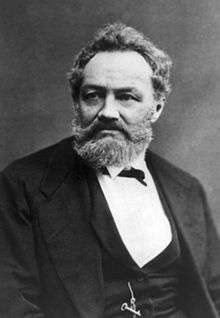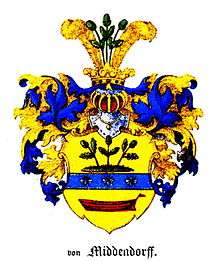Alexander von Middendorff
Alexander Theodor von Middendorff (Russian: Алекса́ндр Фёдорович Ми́ддендорф; tr. Aleksandr Fyodorovich Middendorf; 18 August 1815 – 24 January 1894[2]) was a Russian zoologist and explorer of Baltic German origin.
Alexander von Middendorff | |
|---|---|
 von Middendorff circa 1880 | |
| Born | 18 August [O.S. 6] 1815 |
| Died | 24 January [O.S. 12] 1894 (aged 78) Hellenorm Manor, Hellenorm, Kreis Dorpat, Governorate of Livonia, Russian Empire (present-day Hellenurme, Valga County, Estonia) |
| Resting place | Hellenorm Manor Cemetery, Governorate of Estonia (in present-day Hellenurme, Estonia) |
| Nationality | Baltic German |
| Citizenship | Russian Empire German Confederation German Empire |
| Education | Humboldt University of Berlin University of Erlangen-Nuremberg University of Vienna University of Breslau |
| Alma mater | Imperial University of Dorpat |
| Occupation | Zoologist Explorer |
| Employer | Kiev University St Petersburg Academy of Sciences |

Early life
Middendorff's mother Sophia Johanson (1782–1868), the daughter of an Estonian farmer, had been sent to Saint Petersburg for education by her parents. There she met with the future director of the St. Petersburg Pedagogical Institute, Theodor Johann von Middendorff (1776–1856), whose father was a Baltic German pastor in Karuse, Estonia. As the two young people came from different social ranks and were unable to marry each other, their daughter Anette (b. 1809) and son Alexander were born out of wedlock. Alexander was born on 18 August 1815 in St. Petersburg,[3] but could not be baptized until six months later in the Estonian Lutheran Congregation of St. Petersburg, as the German Lutheran Congregation of St. Petersburg had not agreed to perform the baptism. In the accompanying paperwork, Middendorff's parents registered themselves as a married couple. In order to escape the attention of the public, the mother and son returned to Estonia, where they settled at the Pööravere Mansion. Only in 1824, when the young Middendorff was ready to go to school, was his status legitimized when his parents finally married.[4] (Note: Although his father Theodor was Baltic German, Middendorff's middle name is sometimes spelled as "Theodorowitsch",[5] a German corruption of the Russian patronymic Федорович (Fyodorovich); "-ovich" meaning "the son of" the person (father) whose name precedes it.)
Education
Middendorff received his early education from tutors in Reval and at a gymnasium in Saint Petersburg. From 1832 he pursued a medical degree at the Imperial University of Dorpat where his professors included Georg Friedrich Parrot, Nikolay Ivanovich Pirogov, Hermann Martin Asmuss, and Alexander Friedrich von Hueck. Middendorff graduated in 1837 with a dissertation (written in Latin) on polyps in the bronchi. He then undertook further studies at the Humboldt University of Berlin, University of Erlangen-Nuremberg, University of Vienna, and University of Breslau. In 1839, under the patronage of Karl Ernst von Baer, he accepted a job at Kiev University.
Explorer and scientist
In 1839, Middendorff became Assistant Professor of Zoology at Kiev University.
In the summer of 1840, Baer asked Middendorff to join his second expedition to Novaya Zemlya (the first one took place in 1837). Due to stormy conditions the expedition failed to reach Novaya Zemlya, but Baer and Middendorff explored Russian and Norwegian Lapland, as well as the Barents and White Seas. Middendorff was tasked with crossing on foot the Kola Peninsula and mapping the peninsula from Kola to Kandalaksha while collecting zoological and botanical material.
From 1843 to 1845, on behalf of the St Petersburg Academy of Sciences, he travelled to the Taymyr Peninsula and then along the coast of the Sea of Okhotsk and entered the lower Amur River valley (which at this time was Chinese territory). He published his findings in Reise in den äußersten Norden und Osten Sibiriens (Travels in the extreme north and east of Siberia) in German (1848–1875), which included an account of the effects of permafrost on the spread of animals and plants. He also wrote Die Isepiptesen Russlands (1855), an account of bird migration in Russia, and a monograph on molluscs, Beiträge zu einer Malacozoologia Rossica (1847–1849), in which he coined the term radula.
In 1870 he visited the Baraba steppe and in 1878 the Fergana Valley.
He died at Hellenurme in Livonia, present-day Valga County, Estonia.
Middendorff's grasshopper warbler, Cape Middendorff of Novaya Zemlya, Kodiak bear (Ursus arctos middendorffi), and Middendorff Bay of the Taymyr Peninsula are named after him.
See also
References
- Carl Arvid von Klingspor (1882). Baltisches Wappenbuch. Stockholm. p. 178. ISBN 978-0-543-98710-5. Retrieved 11 April 2019.
- In German personal names, von is a preposition which approximately means of or from and usually denotes some sort of nobility. While von (always lower case) is part of the family name or territorial designation, not a first or middle name, if the noble is referred to by surname alone in English, use Schiller or Clausewitz or Goethe, not von Schiller, etc.
- Faure, Gunter; Mensing, Teresa (2012). The Estonians; The long road to independence. ISBN 9781105530036. Retrieved August 6, 2018.
- Academic Middendorff and Estonians. Eesti Ekspress., 08.29.2005 (in Estonian)
- "Author details for Alexander Theodorowitsch middendorff". IPNI. Retrieved December 3, 2012.
- IPNI. Middend.
- E. Tammiksaar, I. Stone, "Alexander von Middendorff and his expedition to Siberia (1842–1845)", Polar Record 43 (226): 193–216 (2007)
- Barbara and Richard Mearns, Audubon to Xantus, The Lives of Those Commemorated in North American Bird Names, ISBN 0-12-487423-1